

| Glow Worms - a detailed summary 2010 |
| The 2010 Glow Worm season was
another relatively early one, producing the first records
for the UK on May 24th, which was three days ahead of the
earliest here in 2009 and despite following the coldest
Winter for over 20 years. Indications that numbers could be good came in April when we started to record larva along the track stretching from sections A to D in Map 2. But there were fewer larvae of near adult size than in 2009 and we expected the final number of females to be well below that reached the previous year (385) as a result. In fact, it turned out to be a record year for numbers of adults as well, with just over 500 females recorded and very high numbers of males. Once again, Glow Worms were also found to be extending their range at the Clipstone Old Quarter site. |
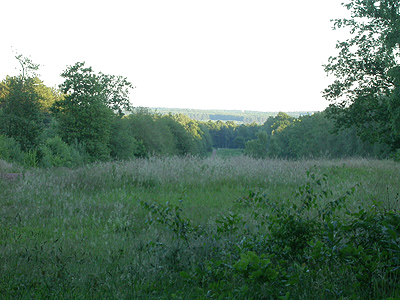 |
|
| .... | ||
| Continuous
coverage was again possible, with visits looking for
females every evening between May 21st and August 12th, a
total of 84 visits. The weather was also helpful in
providing some good data this year, with rain at some
time of the day on just 22 dates, allowing for a
particularly dry period between mid-June and mid-July. This year's glowing peak was flatter than that attained in 2009. There was another large emergence of females on one evening during the second week of June, but not to the scale of that in 2009. This years flat peak was made up of a series of similar emergences, over a four week period from the second week of June until the first week of July. The largest of these emergences was of 37 females on July 1st, but notable counts of new females came with 26 on June 17th, 27 on June 20th, 29 on June 26th and 24 on June 29th. The largest emergence of new females on July 1st, came as a surprise as it was believed at the time that emergences were generally starting to decline. |
||
| .... | ||
| ....... Map 1. ..... Arial map showing the positions of all female Glow Worms at Clipstone Old Quarter during 2010. | ||
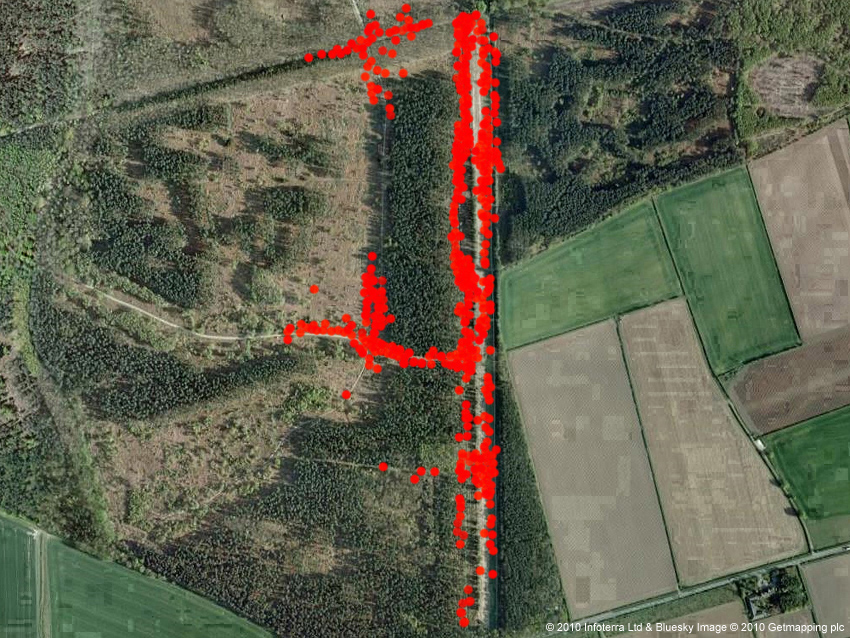 |
||
| ..... |
| What was
especially noticable this year, was the shorter emergence
period of males compared to females. Males were recorded
either with females, or noted in flight by their
characteristic brief flashes low to the vegetation
between May 28th and July 11th, whilst newly emerged
females were recorded between May 24th and July 18th. A
total of 115 males were recorded. The dates on which the
peak number of males was reached, can be gained by
looking at the figures for the total number and
percentage of females glowing for one evening in table
01. June 25-27th produced the highest percentage of such
females (84%) i.e. the peak number of males. But a
percentage of 80% was reached over a longer period
between June 17th and 30th. In 2009, the peak number of
males occurred between June 13th and June 20th, returning
a percentage based on the same basis as 2010 of 72%, but
these dates and figures are strongly influenced by the
extraordinarily large emergence on one date in the second
week of June 2009. The three tables showing the weekly highest counts from 2008-2010, show that three quite different peaks have been attained each year. 2010 differed from both previous years by being longer, especially at the start of the glowing season. The extension of the season into August, was entirely due to the presence of one quite remarkable female (Female 490) which was present for 32 nights, glowing on each night between July 11th and August 11th, but was missing on August 4th only. |
||
| ..... |
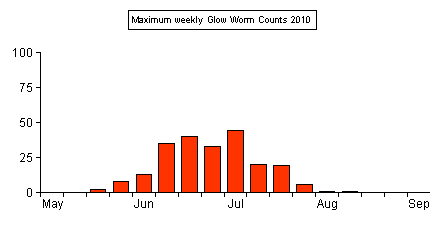 |
|
|||||||||||||||||||||||||||||||||||||||||||||
| ..... | ||||||||||||||||||||||||||||||||||||||||||||||
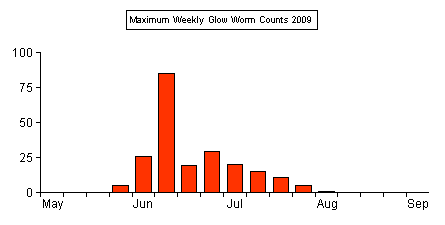 |
|
|||||||||||||||||||||||||||||||||||||||||||||
| ..... | ||||||||||||||||||||||||||||||||||||||||||||||
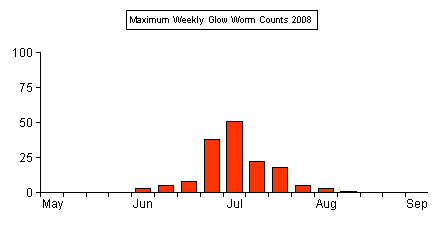 |
|
|||||||||||||||||||||||||||||||||||||||||||||
| ..... | ||||||||||||||||||||||||||||||||||||||||||||||
| Female 490's movements
were minimal for such a long glowing period, moving just
over a metre away from her original location at one
point, before wandering back and then going a short
distance away again, before failing to appear on the last
evening we visited the site. Her movements, like that of
many females which fail to attract a mate within a week,
were presumably made in an effort to find a more
prominent glowing location. On one evening near the end
of her glowing period, we were unable to locate her and
thought she had gone, only to find her over three feet up
a Bracken stem. In terms of size, Female 490 was around average (22mm) and it is not possible to say why she glowed for so long before giving up, yet other unmated females usually give up after about 14-20 evenings. For the last week she was present, her glowing period and brightness varied. |
|
|||||||||||||||||||||||||||||||||||||||||||||||||
| ..... | ||||||||||||||||||||||||||||||||||||||||||||||||||
| As for such a
long time she was the only female present on site, we
sometimes spent much time waiting for her to appear. Her
glowing gradually became more unreliable in nature,
sometimes only glowing for short periods of a few
minutes, but occasionally almost constantly for the
length of time we were there. In a futile effort to
attract a male, the normally slight abdominal waving
employed by female Glow Worms was often grossly
exaggerated and speeded up. The brightness of her glow
also varied and she could occasionally almost switch off,
before suddenly brightening again within a few minutes. Whilst Female 490 failed to attract a male, she was not the only female to remain un-mated. The last female we recorded with a male was on July 10th and we calculated that in order for females to have a good chance of successfully mating and laying eggs, then they have to emerge no later than the first week of July. Admittedly this is a generalised thought, perhaps biased towards both this site and 2010 in particular, but also towards having favourable conditions for larvae to mature in time. Based on the length of the pupation process (larva to pupa) and the actual period spent as a pupa, female larvae probably needed to be fully fed by about the middle of June for an early July emergence and successful mating. |
||||||||||||||||||||||||||||||||||||||||||||||||||
| ..... | ||||||||||||||||||||||||||||||||||||||||||||||||||
| ....... Map 2. ..... Arial map showing the survey areas on site. The survey route taken was area O, R, L, M, N, P, K, J, F, G, H, I, D, E, C, B and A. | ||
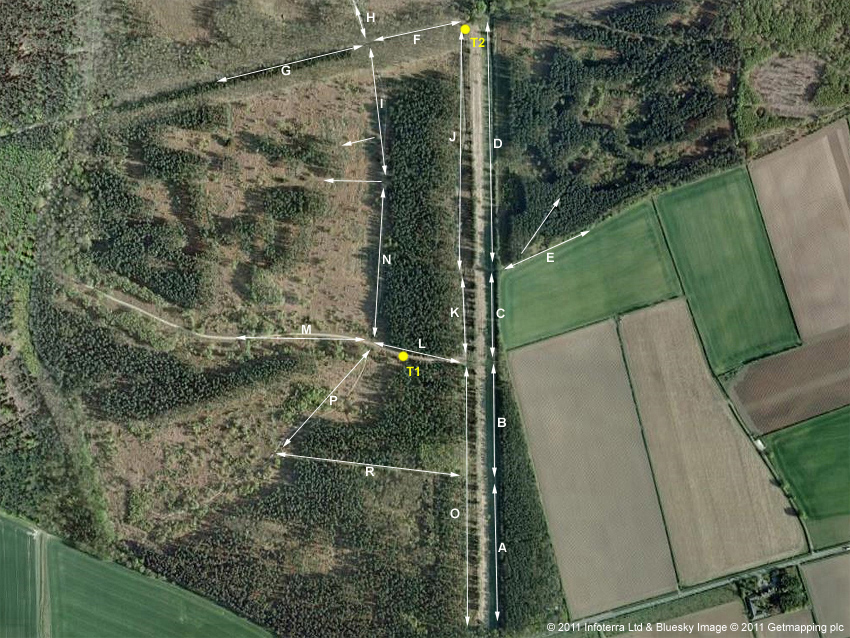 |
||
| ..... |
| Although there were numerous instances of females remaining unmated, several females were relatively spoilt for choice earlier in the season, being found with four or five males present. Interestingly, all these instances occurred on June 20th and 21st and late in the evening (generally near midnight). The majority of females this year, were often found already in copulation at dusk (often within an hour of 21:45h at peak) when we started our surveys and we strongly believe that despite finding just over 500 females, we missed many more during the season. There would obviously be some females that would remain out of sight, away from any of the paths and forest tracks, but with such a large area to cover, some females hatching in areas towards the end of our survey route, were already likely to have glowed, mated and stopped glowing by the time we eventually got to their location. | ||
| ..... | ||
| Quite a number of females
with males, were often found wandering on forest tracks
or descending deeper into vegetation with the male in
tow. It was also quite frequent to record a female
glowing, then for her to have stopped glowing and have
completely disappeared half an hour later on our return.
One particular female actually recorded doing this was
Female 370. She was found glowing with no male at 22:35h,
but had mated, was found wandering near her original
location and had stopped glowing by 23:00h. Breaking the survey route into seperate sections and monitoring the females within them, produced results that were not unexpected and highlighted the variation in emergence timing within each section over the course of the season. The following graphs show the number of new females in each of the 17 sections of the survey area during 2010. The location of females on site was recorded to confirm the belief we had in 2009, that differing sections of the site became 'active' at different times of the glowing season. Interestingly, none of the graphs produced a similar data range to that produced in the graph showing the maximum weekly Glow Worm counts for 2010 (above). |
 |
|
| ..... | ||
| The dense Glow Worm habitat of Section O is shown in the above right photograph. A former grass path cutting through a heavily shaded area of Clipstone Old Quarter, the actual location of the four females found in this section for the first time, lies well behind the two small Birches in the centre of the photograph. | ||
| ..... | ||
| Section A - Grass (sunny, flat aspect) | Section B - Grass (sunny, north-facing)... | |
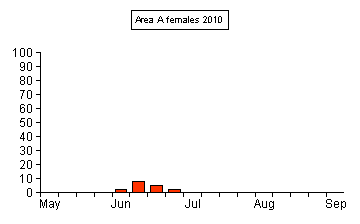 |
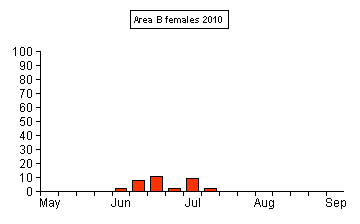 |
|
| The number of females peaked in this section during the second week of June, followed by a gradual decline throughout the rest of the month. No July records. Area active for four weeks. | ..... | Numbers appeared to have peaked in the third week of June, but there was a second small emergence of females in the first week of July, following a drop in the number of new females in the last week of June. No females recorded after the second week of July. |
| ..... | ||
| Section C - Grass (sunny, south-facing)... | Section D - Grass (sunny, south-facing) | |
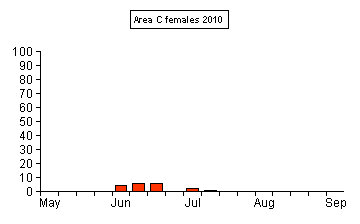 |
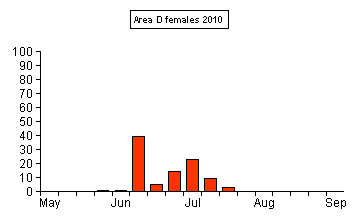 |
|
| Produced low numbers of females per week from early June until the second week of July. As with three of the other grass areas, there was a drop in the number of new females in the last week of June. | ..... | This is the largest of the four predominantly grass survey areas on site, and continued to produce new females until mid July. Very small numbers of new females in the last week of May and first week of June, with a sudden large rise in numbers in the second week of June. Numbers in this area actually produced a more general peak in the first week of July. |
| ..... | ||
| Section E - Forest path (woodland/field edge)... | Section F - Forest track (dense shade)... | |
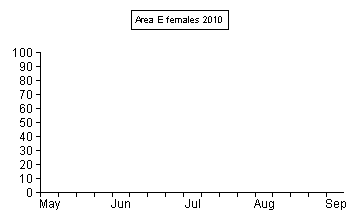 |
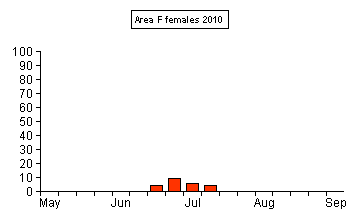 |
|
| Despite continuous surveying, no females appeared in this section during the year. | .... . |
The densely shaded nature of this survey section, meant that (as in 2009) females appeared much later than sunnier/warmer sections. Only small numbers found, spread over four weeks from mid-June to mid-July, with a peak in the last week of June. |
| ..... | ||
| Section G - Forest track (dense shade)... | Section H - Forest track (partial shade)... | |
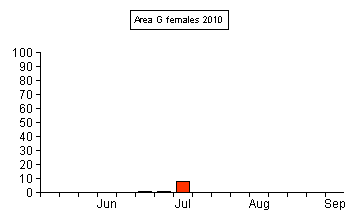 |
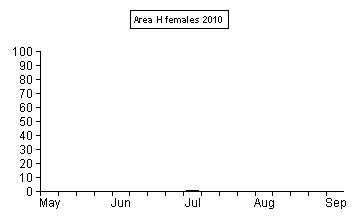 |
|
| This area never produced any numbers and most females were found close to the junction with section F. Only producing new females during three weeks, a pronounced peak occurred in the first week of July. Just single females only in the two weeks prior to the peak, with no further records for the rest of the season. Females found in this section in 2009, made up a large percentage of the totals recorded during the latter few weeks of the 2009 season. | ..... | Like sections F and G, females were recorded in section H for the first time in 2009. Just one female glowed in this section during the first week of July 2010. |
| ..... | ||
| Section I - Minor forest path (enclosed sunny habitat) | Section J - Forest track (enclosed habitat, south facing)... | |
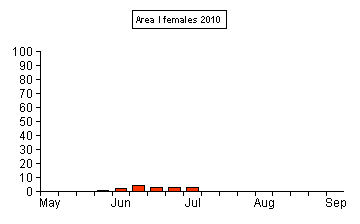 |
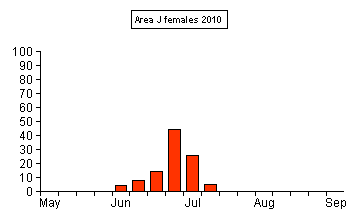 |
|
| There was an increase in the number of females section I produced during 2010 on previous years, with evidence that this area has a small, but growing population. Section I remained active from the end of May, through to the first week of July, but produced only low numbers. | ..... | A very productive area producing females from the first week of June until the second week of July. A clear and pronounced peak came with a large increase in emerging females during the last week of June, interestingly a week earlier than peak numbers of females in section D. |
| ..... | ||
| Section K - Forest track (south facing)... | Section L - Forest track (flat aspect)... | |
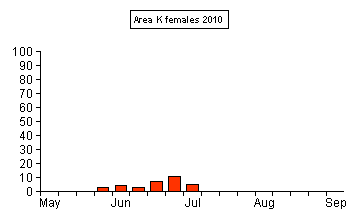 |
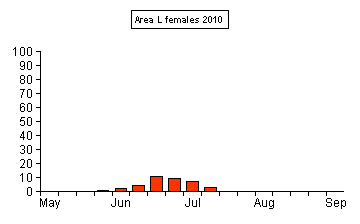 |
|
| This section contains what is most likely to be the warmest section of the entire site and this is likely the cause for producing the first females of the year. Section K remained active from the last week of May, through to the first week of July when emergences stopped. There was a slight peak in the last week of June, but generally the number of females remained low in this section. | ..... | An active section producing some early females. Female activity peaked in mid-June, which was slightly earlier than most other sections, Emergences continued for virtually the whole 'active' season, considerably longer than in 2009. |
| ..... | ||
| Section M - Forest track (flat with open aspect) ... | Section N - Minor forest path (south-facing) ... | |
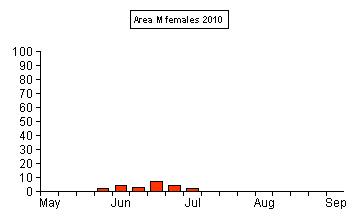 |
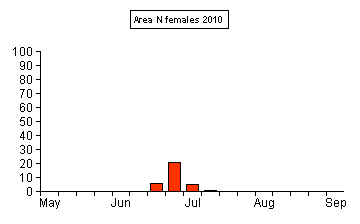 |
|
| The interesting fct about the females appearing in this section, was that all appeared on one side of the track, apart from three. Section M remained active for longer than in 2009, with females recorded from the last week of May, through to early July. | ..... | Despite running directly off the forest track in section M, it took over three weeks for section N to become active. It eventually produced a pronounced peak of females in the last week of June and the number of females in this section was greatly up on 2009 figures. |
| ..... | ||
| Section O - Forest track (enclosed, flat, becoming north-facing) ... | Section P - Forest track (north-facing).. | |
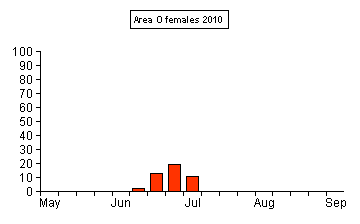 |
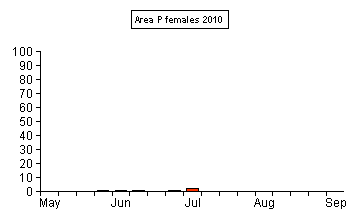 |
|
| Another productive section, although most of the females were confined to the flat section of this track. Peak numbers were again in the last week of June. | ..... | This section produced no females during 2009, but small numbers were found from the last week of May and continuing until the first week of July. Females along here, are believed to be moving away from the adjacent areas of sections L and M. |
| ..... | ||
| Section O - Overgrown former grass path (dense shade and flat) ... | ||
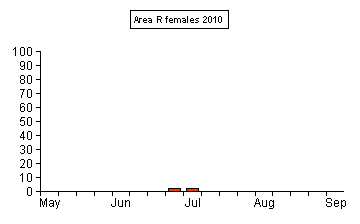 |
Section
D remained the most active area, producing new females over an eight
week period, but this area was also notable in accounting for numerous
emergences in the second week of June. This peak shows up much less on the graph showing the maximum weekly Glow Worm counts for 2010, than it does on the graph for Section D itself. None of the other survey sections produced such a similar early peak in numbers and the reason for this is still unexplained, but there was a similar peak in the same area and week in 2009. Although by area, Section D is the largest of the 17 survey sections, the fact that around 85% of the females were found in the grass strip that makes up about 50% of the whole of Section D, considerably reduces the argument for larger area - in effect, a proportionally higher female count. |
|
| The four females found along this heavily overgrown section, represented a second new area in which we had not found females before. Females were discovered here during a quick check away from an active area of section O, in the last week of June, indicating that females may have been found here a week or so earlier if the path had been checked then. | ||
| ..... | ||
| Section L was another active section
although the peak in numbers in this section were much
lower than in 2009. Section L continued to produce new
females for much of the season in 2010, but by the end of
June 2009, Glow Worm activity in both this section and
the adjacent section M had ceased. 2010 results clearly show that Glow Worms are continuing to spread at this site, with females found in two completely new areas this year, indicating that the colony is continuing to spread west along the forest tracks and pathways, away from the grass strip found within survey areas A, B, C and D. We continue to recieve second and third hand reports that Glow Worms were found in the grass strip (certainly near the Centre Tree) many years ago. Section P was the second new area in which females were found. This section was checked repeatedly in 2009 with no records, but an early female (Female 003) was found glowing here in the last week of May. There were no records from Section E, which runs away east from the junction of Sections C and D and we again made occasional checks along all the main tracks in this area. With a tiny Glow Worm population present deep within the Sherwood Forest Country Park area, we thought that it might be possible that the two populations are still linked (albeit tenuously) but found that they are indeed seperate. With the less worked habitat within the Country Park, it might be thought that the Glow Worm population here would be much greater than the generally forested site of Clipstone Old Quarter. The evidence does not support this though and if the Country Park did once have a healthy population, it is long gone despite having habitat seemingly more suitable and less disturbed to that found at Clipstone Old Quarter. This situation does help to show how Glow Worm populations within the whole of The Dukeries, have become more isolated over time through road construction, agriculture, housing development and habitat loss. |
||
| ..... |
| Glow Worm larval
summary 2010 Larvae were only counted along the lengthy section of cycle path on site (Sections A-D). The track runs north to south and was walked it's full length twice during counting, with around an hour spent each visit. The path was re-surfaced over Winter and heavy machinery had been used. Although a protective track was laid over the grass, to try and lessen the amount of affect on invertebrates, this did compact the grass and soil adjacent to the path. The number and size ranges of Glow Worm larvae recorded at Clipstone Old Quarter was considerably different from the corresponding period in 2009. Comparison between the two graphs produced below, show that many more smaller larvae in the 12-16mm and 17-21mm size ranges were recorded this year. A steady number of larvae of all sizes were recorded during the first three weeks of April, but the last week saw a huge rise in the number of larvae found and produced over 50 larvae, which was more than half of the full total of larvae found in 2009. |
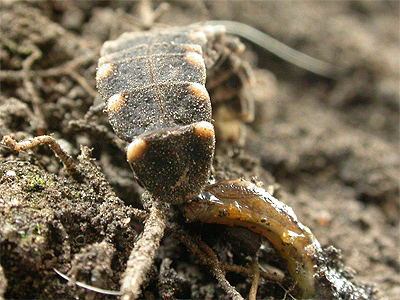 |
|
| ..... | ||
| Again fewer larger larvae were
found, which at the time was thought likely to indicate
lower numbers of adults in the Spring and Summer. After
this peak, larval numbers during May dropped considerably
and several visits often failed to produce any larvae at
all. Larvae in the small size ranges virtually
disappeared until late in May and the small weekly counts
of full grown larvae, could have meant that the lengthy
pupation process began slightly earlier this year. After
having the coldest Winter for a couple of decades, the
number of larvae we found this Spring was surprising.
Clearly Glow Worm larvae are not susceptible to cold
conditions and survived the Winter unscathed. A sad
aspect to report though, is the number of dead larvae we
found this year. A total of nine were found, all either
trampled underfoot or crushed by bicycles. The photograph above right, shows a full grown larva we had in captivity, found in another area of Clipstone Old Quarter where no larval counts are conducted. She started the pupation process on May 6th, pupated on May 11th and hatched as an adult on May 21st. She was released on May 24th and does not feature in any of the counts made during 2010. An interesting observation we never noticed with females in the pupal stage last year, was the unhatched females ability to glow fully from about 48 hours prior to emergence, although the glowing period was only for several minutes at a time. |
||
| ..... | |
| Comparison with
larval sizes found in 2010 and 2009 |
|
| ..... | |
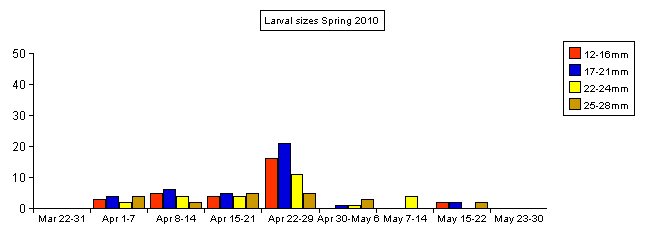 |
|
| ..... | |
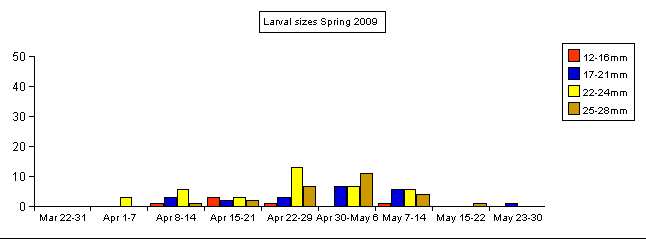 |